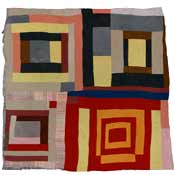
What’s the best abstract art ever made in America? A friend of mine enjoyed asking students this question, and when they predictably answered “Pollock,” a look of disgust would flicker across his face and he’d mutter: “Naaaah … You forgot the Navajo women.” Of course, it was unfair to compare apples and oranges – modernist paintings and Indian weavings – but the ploy invariably shook his students. Its effect did not depend simply upon the recognition that a great Navajo rug can be as visually powerful as a modernist painting. That’s just Modernism 101. No, something deeper is at work whenever comparisons of this kind are made before a contemporary audience. The Quilts of Gee’s Bend, which recently opened at the Whitney Museum of American Art, is a telling example of the phenomenon. Many of the quilts on view could almost be, if you squint, works of geometric abstraction by modern painters. But that alone cannot explain why the show is a hit, attracting a large crowd of New Yorkers.
Folded into a remote curve of the Alabama River not far from Selma, Gee’s Bend was for generations an isolated hamlet. A paved road did not reach the town until 1967. Its people were tenant farmers, many of them the descendants of slaves from the local plantation. They raised hogs and chickens, lived in rough log cabins, plowed with mules, and picked cotton. The women of Gee’s Bend made quilts from abandoned scraps of cloth, such as worn-out dungarees and cornmeal sacks. Their isolation allowed strong family quilting styles with names like Log Cabin and Housetop to develop over generations, without competition from the world beyond. Very occasionally, outsiders discovered and sometimes romanticized Gee’s Bend as a town that time forgot – first in the thirties, when the town was depicted as a place untouched by the modern world, an “Alabama Africa,” and then again during the civil-rights era. The current exhibit, which has been organized by the Museum of Fine Arts, Houston, and Tinwood Alliance, Atlanta, contains 60 quilts by 45 women from the town.
The quilts themselves are startlingly beautiful. They usually begin – but do not end – with a simple geometric pattern. There is no imprisoning symmetry. Like a jazz or blues singer teasing apart a melody, the artists play off their grids with unexpected riffs of color and form. The rippling of the cloth and the individuality of the sewing hand further animate the conceptual geometry. Again and again, the mind wonders, “Why’d she put that there? Why that strand of color below this bold shape?” However, the eye simply delights in the surprising rightness of such decisions. In their way, the artists of Gee’s Bend are formalists, relying for expressive power not on illustrations but on the pure passions of the eye. “I never did like the book patterns some people had,” says Annie Mae Young, one of the strongest artists in the show. “Those things had too many little bitty blocks. I like big pieces and long strips … I work it out, study the way to make it, get it to be right, kind of like working a puzzle. You find the colors and the shapes and certain fabrics that work out right.”
While relishing the formal bravura of these quilts, New Yorkers also respond to them in ways that would surprise the women of Gee’s Bend – or, for that matter, Navajo weavers. This town with the fetching name arouses the usual modern longing for a lost community. The artists themselves are unsentimental about life in an impoverished rural village (as interviews in the catalogue attest) but possess family and spiritual resources New Yorkers often lack. They remind the knowledgeable of what everyone knows but also forgets – that creating significant art is not always the preserve of lonely genius or ambitious M.F.A.’s. For millennia, of course, women in traditional societies have worked with clay and cloth, making an earthy household art of closeness and enfolding warmth. Art rarely fulfills that function anymore. Art is for rich people. Art is something to visit in a museum. Art is for scratching your head. The women of Gee’s Bend stitched together their pieces, integrating their art with their lives. Using worn-out dungarees in a quilt became a form of resurrection.
Art Listings
•Openings & Closings
•Museums
•Galleries
•Photography
•More
The Quilts of Gee’s Bend
At the Whitney Museum of American Art; through March 9, 2003.